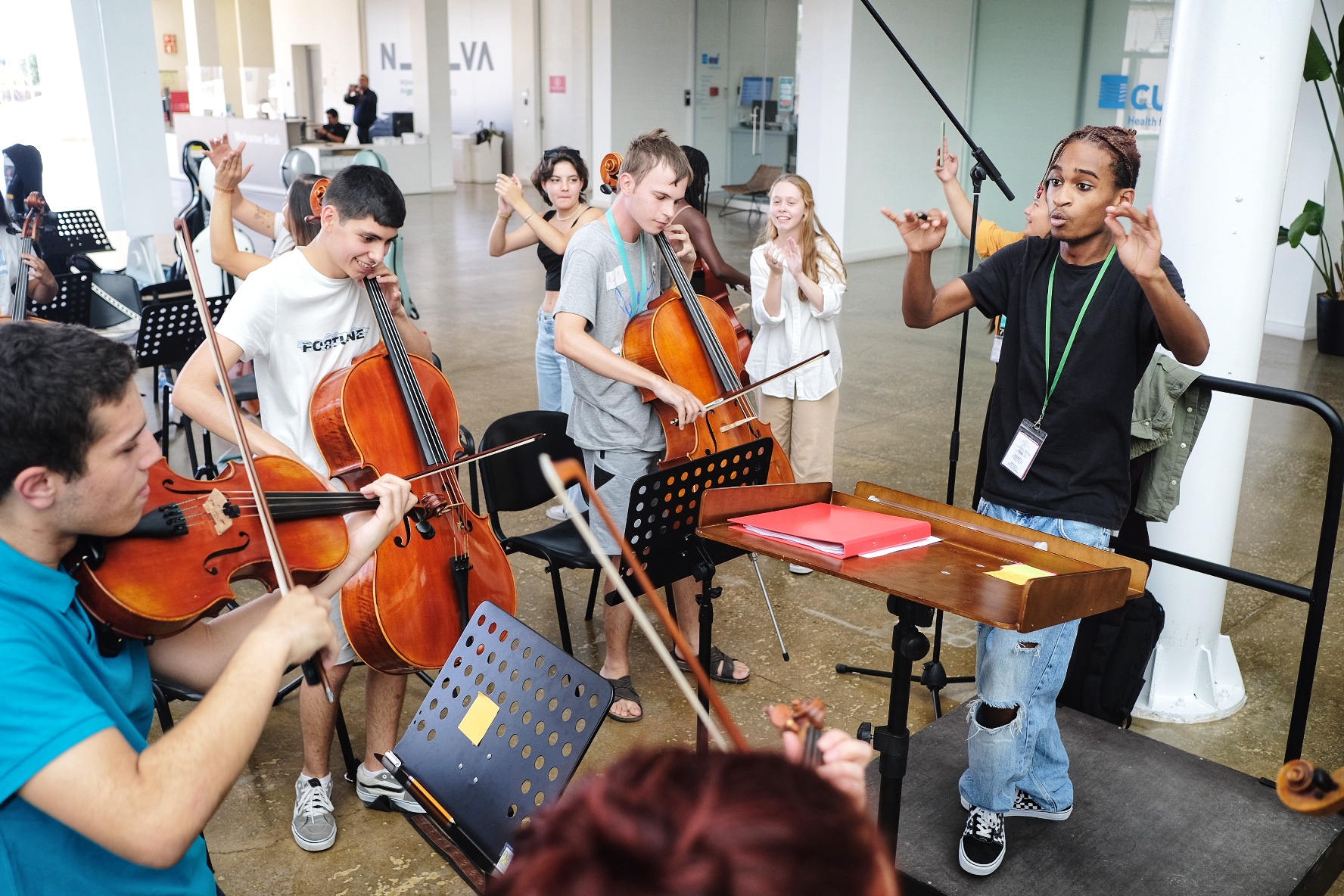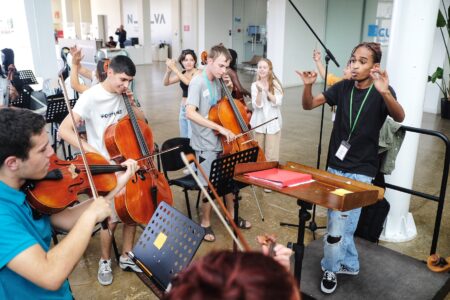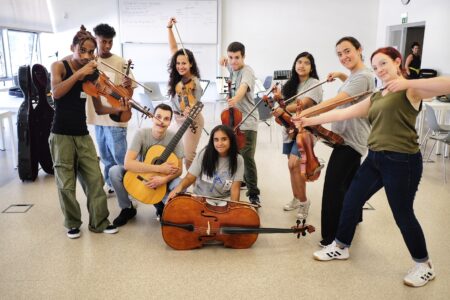
Topics
News & Resources
AIM’s Music Capsules Offer Snapshots of How We Learn
Fiona Cunningham, Director, Academy for Impact through Music (AIM)

If you’re a teaching artist, or have ever been one, you’ve probably wondered: Should I always take the lead in the learning process? Are there ways students can take the lead sometimes? What’s the best way for my students to learn?
Such questions are often the focus of “The Firebird Fellowship,” the program at the heart of the Academy for Impact through Music (AIM), a global innovation lab for changemakers tackling educational inequality through music education. The Fellowship offers a 15-month immersive learning journey to 40 dedicated teachers from music for social action programs around the world, centered around AIM’s five “pillars”: holistic development, intrinsic motivation, unlimited artistry, optimal agency, and community. The Fellowship’s aim is to disrupt outdated modes of teaching, particularly where the impact of poor teaching compounds inequity of opportunity, and to provoke changes in teachers’ training and approach to music learning that can radically transform students’ learning experiences.
This article spotlights three of AIM’s “Music Capsules,” short video performances that highlight new approaches to teaching and learning. They were made by Firebird Fellows applying new approaches to teaching and learning during their 2022 summer residency with teenaged students (“Young Leaders”) from programs in ten different countries. (All of the 2022 Firebirds’ Music Capsules can be found on AIM’s Vimeo account and on Instagram.)
These are not final-cut, polished music videos; instead, each capsule captures teachers and students in the midst of learning experiments that aimed to challenge the less productive aspects of traditional instrumental instruction. In particular, we wanted to address the false dichotomy between artistry and student agency and to help teachers and students experiment with how the two can and should inform one another.
We wanted these music capsules to be replayable again and again by the people featured in them—to become musical souvenirs, calling cards, soundtracks, memories. And we wanted the Young Leaders to be able to share their learning and accomplishments with their family members, friends, and perhaps even as part of their CV.
We are excited to share these videos with you! As you watch, we invite you to consider what deviates from the “master and apprentice,” maestro-led models of music making, and to think about the potential of those choices are for both youth development outcomes and artistic outcomes.
1. String Quartet Capsule
Optimal Agency: Exploring Musical Decision-Making and Ownership
“All musicians should learn to play in small ensembles, not just in big orchestras, even when they are small. They need to feel their own voice is important…and not be fearful to express themselves. They need to be able to start making their own musical decisions, even at a young age.” —Patricia, student violist, Orquestra Geraçao, featured in this capsule
“At first we thought, ‘We’re going to have to double up on the Dvorak because it’s quite difficult.’ Then we thought—‘They’ve got this, they can do it.’”— Sebastian Ostertag, Firebird

In this capsule, teachers play mentoring and coaching roles for their students, mostly behind the scenes. The Dvorak movement is challenging, and at some point during filming, student nerves started affecting their performance. The teachers spontaneously offered to become a “backing band” for each quartet member, so that each could focus solely on their own performance.
So, you may notice a few places where the musicians seem more like soloists, immersed in their own sound world. Each student is enjoying the expressive freedom that comes with playing with the support of professional musicians. The students are in the lead; the teachers are percussive “wingmen.”
The teachers also gave the quartet full leadership of their performance concept. The students decided to play in the dark, and to incorporate the synesthesia of the cellist to inform the video backdrop for their performance.
Consider the positive potential of these dynamics between teachers and students. How different might these performances have been if the teachers, instead of leading a learning process focused on their students’ agency and ownership, had seen it as an assignment: “We need to them to perform the Dvorak in one week—”?
2. String Ensemble Capsule
Unlimited Artistry: Stretching our artistry is not always easy or comfortable
This music capsule brings together excerpts of works by two young contemporary female composers: The Hunt, by 14-year-old Jordan Millar, a ‘Very Young Composer’ with New York Philharmonic, and MMXX [a L.O.T.], by Edvania Moreno, a graduate from Orquestra Geraçao and member of the ensemble Active Mess. The Hunt meets MMXX (around 2:38) via a poem composed in three languages by the Young Leaders.
These small-ensemble choices offered real challenges for young musicians used to playing only in large orchestras. The Hunt requires sustained tension and a level of deliberate discomfort and uncertainty—a far cry from the conjunct pomp of many classic youth orchestra choices, and wholly new for most of the Young Leaders. One teaching strategy was to quickly establish peer leadership rotations, inviting different members of the small ensembles to be responsible for leading entries through breath, gesture, and eye contact.

Any first experiment involves risk, a leap of faith, the possibility of failure. I caught some of those first tentative experiments, and I saw students with shoulders closed inwards to diminish the self and eyes fixed anywhere but on their peers’ faces. But over the days, shoulders opened out, eyes connected, gestures owned the space. One catalyst for this was the Firebirds’ reframing the narrative from “This is difficult to learn” to “This piece is intentionally tense and suspenseful; let’s release the tensions we feel into the intention of the music.”
The composer’s words about a hunt as an invisible, ever-present threat became a place for building character and story; the students decided to perform it in the wooded areas around our learning campus. For MMXX, which was inspired by the impact of the 2020 pandemic, the student performers decided that the glass walls of the university campus provided a way to present social distancing and isolation. Teachers told us afterwards that their students were intrinsically motivated to build their own performance concept—a nice example of how a work of art that spoke directly to the lived experiences of our students ignited their collective creative ownership.
“It can’t only be done sitting in a chair, with a stand, listening to the conductor in a very traditional way.” —Francesca, a Young Leader
When young people are allowed to take more ownership of their artistic and personal development, they can start to become positive disruptors of traditional learning methods and drive change with their teachers. The question is not whether they are capable; it is: “Are we, as educators, ready and able to activate their unlimited artistry, and indeed our own?”
3. Cello Ensemble Capsule
Focus on Community: Human Connection and Equity at Heart
“We had the challenge of bringing a piece by Bach together with one explicitly inspired by Bach (that’s why it’s called ‘Bachiana’), composed in Brazil. We wanted to experiment with percussion and develop the rhythmic elements of the piece. The idea of improvisation came from the students. They made a proposal amongst themselves and had time on their own to figure out how to do it. We achieved a lot in a very short period of time.” —Pablo Silva, Firebird, Teatro del Lago
In this cello capsule, the body mirroring we see between students and between students and teachers was introduced by one of our Firebirds as a way to establish deeper human connection, empathy, and equality between all players, as well as release from self-consciousness about physical gesture. It became such a meaningful ritual for their daily learning that they built it into their artistic presentation.
Notice the moment (00:38) when the four teachers playing Bach “pass the baton” to the four students, all from different countries. There is something poignant about the vulnerability of the teachers being supported by four students, the solitary sound bolstered by the loving hope of the young, a next generation bringing depth and beauty to the sound. What will they carry forward?
Also, notice teachers using their cellos as percussive accompaniment in the Villa Lobos…a student cellist accompanying her peers on djembe while they explore improvisation solos…and the cellos themselves as visual equalisers, an octet of humans, not functions. These small decisions were deliberate and intentional; they speak to the culture created by this group over just six days. For me, they enrich the artistic performance.
What did we want these performances to illuminate?
New Firebirds often ask us, “How do I focus on the five AIM pillars as well as getting performance excellence, or without sacrificing it?” Our question in response is, “How can artistic excellence exist without embodiment of these five pillars in the music-making?”
We had two key driving motivations for this project:
- to challenge the limiting belief that artistry is sacrificed when youth ownership, ideas, and direction come into play.
- to illustrate how musical performance itself is an obvious place to find evidence of empowered learning processes and youth development outcomes.
In addition, we had two key questions to ask ourselves:
- If we agree that all young musicians deserve our higher aspirations and investment in their development, rather than that they simply learn to follow a conductor’s instructions and the notated score, and mechanically operate their instruments, what processes and environments do we, as educators and leaders, need to utilise to ignite deeper artistry in our students?
- When we watch and hear the flowering product of that learning—musical performance—how can we tell that a deeper artistry is being ignited? What evidence in musical performance gives us confidence that we are helping equip students with the kinds of skills and mindsets that will serve them in life?
AIM’s five pillars are never about stopping music to focus on youth development outcomes. I hope these music capsules show how, when teachers shift their perspective from performance to student development, as the primary outcome, the artistic results need not suffer. They can, in fact, be better.

